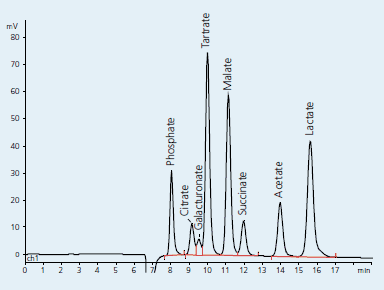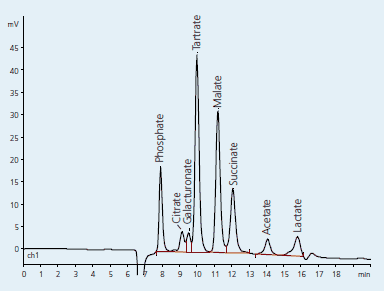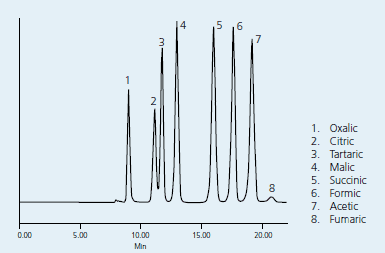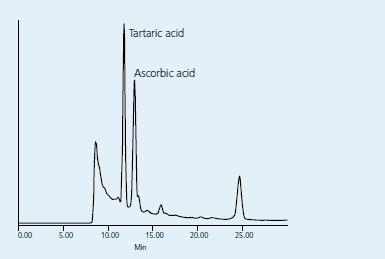Organic Acid Determination in Wine and Fruit Juices
Our brand standard solutions ensure reliable quantification
The measurement of organic acids in wines is complementary to sensorial and microbiological quality assessment in fermentation control, for example, because the types and concentrations of the different acids influence the resulting color and taste of the wine. Winemakers must monitor the concentration of various organic acids to ensure the quality of their wines. Tartaric, citric, and malic acid are added to adjust the pH. Malic acid levels must be monitored closely as many wines undergo a malolactic bacterial fermentation which reduces the acidity of the wine, as the malic acid is converted to lactic acid. Acetic acid is the main product of oxidation and can also spoil a wine.
In this article, we describe two different applications, both of which benefit by using high-quality organic acid standards:
- Determination of organic acids in red and white wines
- Separation of organic acids in fruit juices
Part 1: Organic acids in red and white wines
Our aim in this project was to use ion exclusion chromatography for the simultaneous determination of the following organic acids of primary importance in wine: phosphoric acid, citric acid, tartaric acid, galacturonic acid, malic acid, succinic acid, lactic acid and acetic acid. Additionally, we compared two different sample preparation techniques that are common in the food industry: off-line with SPE and on-line with dialysis.
The wine samples were from Switzerland and Germany:
White wine:
(1) Müller-Thurgau, Baden (D)
(2) RieslingxSylvaner, Graubünden (CH)
Red wine:
(3) Merlot, Ticino (CH)
(4) Zizerser Blauburgunder, Malans (CH)
The HPLC analyses were performed using ion exclusion chromatography with conductivity detection on a sulfonated resin in the H+ form (e.g. SUPELCOGEL C- 610H column or equivalent) by A. Rumi, Metrohm Ltd., Switzerland.
Sample preparation
1. Sample preparation using SPE
Wine samples spiked with organic standard solutions, non-spiked wine samples, a blank solution and standard solutions for calibration were extracted by SPE using the following protocol:
SPE protocol
- Condition the Supelclean LC-4 cartridge (Supelco, Cat. No. 57089) with 2 mL methanol followed by 4 mL eluent
- Add 1 mL sample solution with a micropipette having disposable tips
- Elute with 4 x 2 mL eluent
- Fill to the final volume with eluent
2. Sample preparation using dialysis
The wine samples and standard solutions were diluted with eluent to the final volume and dialysed (dialysis cell, Metrohm).
Examples of the separation of an SPE extract of organic acid standards and a white wine sample are shown in Figures 1 and 2, respectively. A linear response for each acid at five different concentrations was achieved. The concentrations of the standard solutions were chosen in such a way that the whole expected concentration range of each acid in the samples was covered. The precision was determined by consecutive injections of blank wine samples and spiked ones.

Figure 1 .Organic acid standards (after SPE)

Figure 2.Organic acids in white wine 1, Müller-Thurgau (after SPE)
Conditions (Figures 1 and 2):
Column: Ion exclusion HPLC column (H+ form), 25 cm x 8 mm
Mobile Phase: 1.9 mM H2SO4 + 2% acetonitrile in ultra pure water
Col. Temp.: 75 °C; Flow Rate: 0.6 mL/min; Det.: Conductivity
Both sample preparation methods provided adequate recoveries; the SPE recoveries were 70-100%, while the dialysis gave recoveries of 82-100%. The simultaneous determination of organic acids (Table 1) with ion exclusion chromatography and conductivity detection represents a simple and fast method for the determination of this group of substances. A short analysis time is sufficient to resolve relevant acids with a concentration > 0.1g/L. The determination is fully automatable.
Part 2: Separation of organic acids in fruit beverages
This application uses a SUPELCOGEL C-610H HPLC column and UV detection for the simultaneous determination of organic acids in various fruit beverages. This column is a cross-linked polystyrene divinylbenzene resin HPLC column prepared specifically for ion exchange analysis of organic acids. It is also ideal for separating sugars, alcohols and other fermentation products.

Figure 3.Organic Acid Standards Mix (10 μL injected)

Figure 4.Grape Juice Cocktail (10 μL injected)
Analyses are best performed at low pH (a 0.1% phosphoric acid mobile phase is commonly used). Organic acids were detected in a standard mix and in grape juice cocktail at 210 nm (Figures 3 and 4). The samples were filtered through a 0.45 μm syringe-tip prior to injection onto the column.
Care should be taken in the selection of column temperature to assure the best overall separation of the components of interest. While separating a standard mix containing oxalic, citric, tartaric, malic, succinic, formic, acetic and fumaric acids at temperatures ranging from 30 °C to 60 °C, it was found that the retention time for fumaric acid shifted drastically. At 60 °C, fumaric acid coeluted with formic acid, while it coeluted with acetic acid at 40 °C. A satisfactory separation was obtained at 30 °C, with fumaric acid eluting at 20 minutes. Retention time shifts for the other components were negligible.
Conditions (Figures 3 and 4):
Column: SUPELCOGEL C-610H, 30 cm x 7.8 mm ID (Cat. No. 59320-U)
Mobile Phase: 0.1% H3PO4
Col. Temp.: 30 °C; Flow Rate: 0.5 mL/min; Det.: UV 210 nm
Related Products
To continue reading please sign in or create an account.
Don't Have An Account?